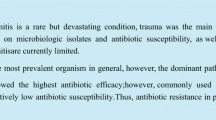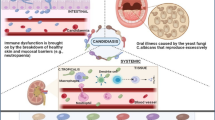Abstract
A prospective observational study was conducted for 18 months to analyze the mycological profile of clinically suspected cases of fungal rhinosinusitis requiring endoscopic sinus surgery and test antifungal susceptibility of the isolates according to Clinical and Laboratory Standards Institute guidelines. Per-operative biopsies (n = 126) from 106 patients were processed by standard mycological procedures. Out of 126 samples, 59 (46.83 %) had fungal elements on KOH mount examination. Fungal growth was obtained in 76 (60.32 %) samples, of which single fungal organism was isolated in 68 samples and more than one fungal species in eight samples. The most common isolates belonged to the genus Aspergillus (n = 53, A. flavus being most common) followed by mucormycetes (9), Candida species (7), Penicillium species (5), Alternaria species (5), Fusarium species (1), Curvularia species (1) and black yeast (1). Two hyaline septate fungal isolates could not be identified. Aspergillus species were susceptible to amphotericin B (n = 46), itraconazole (n = 48), voriconazole (n = 52), posaconazole (n = 53), caspofungin (n = 51), anidulafungin (n = 53) and micafungin (n = 53). All mucormycetes isolates (n = 9) were susceptible to amphotericin B, posaconazole and itraconazole. Filamentous non-Aspergillus, non-mucormycetes isolates (n = 15) were susceptible to amphotericin B (n = 12), itraconazole (n = 13), voriconazole (n = 15), posaconazole (n = 15) and echinocandins (n = 15). Amongst the 07 Candida species, 05 isolates of Candida tropicalis were susceptible to amphotericin B, posaconazole, echinocandins and 5-flucytosine; one isolate of Candida albicans had the same susceptibility but was resistant to 5-flucytosine also, and one strain of Candida species was susceptible to all the nine antifungal drugs.


Similar content being viewed by others
References
Fokkens WK, Lund VJ, Mullol J, Bachert C, Cohen N, Cobo R, et al. European position paper on nasal polyps. Rhinology. 2007;45:1–139.
Meltzer EO, Hamilos DL. Rhinosinusitis diagnosis and management for the clinician: a synopsis of recent consensus guidelines. Mayo Clin Proc. 2011;86:427–43.
Chakrabarti A, Denning DW, Ferguson BJ, Ponikau J, Buzina W, Kita H, et al. Fungal Rhinosinusitis: a categorization and definitional schema addressing current controversies. Laryngoscope. 2009;119:1809–18.
Meltzer EO, Hamilos DL, Hadley JA, Lanza DC, Marple BF, Nicklas RA, et al. Rhinosinusitis: establishing definitions for clinical research and patient care. J Allergy Clin Immunol. 2004;114:155–212.
Devaiah AK. Adult chronic rhinosinusitis: diagnosis and dilemmas. Otolaryngol Clin N Am. 2004;37:243–52.
Slavin RG, Spector SL, Bernstein IL. The diagnosis and management of sinusitis: a practice parameter update. J Allergy Clin Immunol. 2005;116:S13–47.
Kennedy DW, Bolger WE, Zinreich SJ. Diseases of the sinuses. London: BC Decker; 2001.
Panda NK, Sharma SC, Chakrabarti A, Mann SBS. Paranasal sinus mycoses in north India. Mycoses. 1998;41:281–6.
deShazo RD, Chapin K, Swain RE. Current concepts: fungal sinusitis. N Engl J Med. 1997;337:254–9.
deShazo RD, Swain RE. Diagnostic criteria for allergic fungal sinusitis. J Allery Clin Immunol. 1995;96:24–35.
Chander J. Textbook of medical mycology. 3rd ed. New Delhi: Mehta Publishers; 2009.
Al-Mujaini A, Wali U, Alkhabori M. Functional endoscopic sinus surgery: indications and complications in the ophthalmic field. Oman Med J. 2009;24:70–80.
Mackay IS, Bull TR. Scott–Brown’s otolaryngology. 6th ed. Oxford: Reed Educational and Professional Publishing; 1997.
Walsh TJ, Anaissie EJ, Denning DW, Herbrecht R, Kontoyiannis DP, Marr KA, et al. Treatment of Aspergillosis: clinical practice guidelines of the infectious diseases Society of America. Clin Infect Dis. 2008;46:327–60.
Ghannoum MA, Rice LB. Antifungal agents: mode of action, mechanisms of resistance and correlation of these mechanisms with bacterial resistance. Clin Microbiol Rev. 1999;12:501–17.
Rodriguez-Tudela JL, Arendrup MC, Arikan S, Barchiesi F, Bille J, Chryssanthou E, et al. EUCAST Definitive Document E.Def 9.1: Method for the determination of broth dilution minimum inhibitory concentrations of antifungal agents for conidia forming moulds. EUCAST E.Def 9.1 2008;1–13.
Clinical and Laboratory Standards Institute. Reference method for broth dilution antifungal susceptibility testing of filamentous fungi; approved standard-second edition. CLSI document M38-A3. Wayne, PA: CLSI; 2008.
Ryan D. Management of acute rhinosinusitis in primary care: changing paradigms and the emerging role of intranasal corticosteroids. Prim Care Respir J. 2008;17:148–55.
Fagnan LJ. Acute sinusitis: a cost-effective approach to diagnosis and treatment. Am Fam Phys. 1998;58:1795–802.
Donald PJ, Gluckman JL, Rice DH. The sinuses. New York: Raven Press; 1995.
deHoog GS, Guarro J, Gené J, Figueras MJ. Atlas of clinical fungi. Centraalbureau voor Schimmelcultures. 2nd ed. Reus, Spain: Utrecht, Netherlands/UniversitatRovira I Virgili; 2000.
Clinical and Laboratory Standards Institute. Reference method for broth dilution antifungal susceptibility testing of yeast; approved standard-third edition. CLSI document M27-A3. Wayne, PA: CLSI; 2008.
Granville L, Chirala M, Cernoch P, Ostrowski M, Truong LD. Fungal sinusitis: histologic spectrum and correlation with culture. Hum Pathol. 2004;35:474–81.
Dall’Igna C, Palombini BC, Anselmi F, Araújo E, Dall’Igna DP. Fungal rhinosinusitis in patients with chronic sinusal disease. Rev Bras Otorrinolaringol. 2005;71:712–20.
Challa S, Uppin SG, Hanumanthu S, Panigrahi MK, Purohit AK, Sattaluri S, et al. Fungal rhinosinusitis: a clinicopathological study from south India. Eur Arch Otorhinolaryngol. 2010;267:1239–45.
Luong A, Marple B. The role of fungi in chronic rhinosinusitis. Otolaryngol Clin N Am. 2005;38:1203–13.
Aribandi M, McCoy VA, Bazan C. Imaging features of invasive and noninvasive fungal sinusitis: a review. Radiographics. 2007;27:1283–96.
deShazo RD, O’Brien M, Chapin K, Soto-Aguilar M, Gardner L, Swain R. A new classification and diagnostic criteria for invasive fungal sinusitis. Otolaryngol Head Neck Surg. 1997;123:1181–8.
Chen CY, Sheng WH, Cheng A, Chen YC, Tsay W, Tang JL, et al. Invasive fungal sinusitis in patients with hematological malignancy: 15 years experience in a single university hospital in Taiwan. BMC Infect Dis. 2011;11:250.
Cody DT, Neel HB, Ferreiro JA, et al. Allergic fungal sinusitis: the Mayo Clinic experience. Laryngoscope. 1994;104:1074–9.
Chakrabarti A, Sharma SC. Paranasal sinus mycoses. Indian J Chest Dis Allied Sci. 2000;42:293–304.
Torres C, Ro JY, El-Naggar AK, Sim SJ, Weber RS, Ayala AG. Allergic fungal sinusitis: a clinicopathological study of 16 cases. Hum Pathol. 1996;27:793–9.
Macmillan RH, Copper PH, Body BA, Hills AS. Allergic fungal sinusitis due to Curvularia lunata. Hum Pathol. 1987;18:960–4.
Houser SM, Corey JP. Allergic fungal rhinosinusitis—pathophysiology, epidemiology and diagnosis. Otolaryngol Clin N Am. 2000;33:399–408.
Chatterjee SS, Chakrabarti A. Epidemiology and medical mycology of fungal rhinosinusitis. Otorhinolaryngol Clin Int J. 2009;1:1–13.
Schubert MS, Goetz DW. Evaluation and treatment of allergic fungal sinusitis. Demographics and diagnosis. J Allergy Clin Immunol. 1998;102:387–94.
Reddy CEE, Gupta AK, Singh P, Mann SBS. Imaging of granulomatous and chronic invasive fungal sinusitis: comparison with allergic fungal sinusitis. Otolaryngol Head Neck Surg. 2010;143:294–300.
Das A, Bal A, Chakrabarti A, Panda N, Joshi K. Spectrum of fungal rhinosinusitis; histopathologist’s perspective. Histopathology. 2009;54:854–9.
Michael RC, Michael JS, Ashbee RH, Mathews MS. Mycological profile of fungal sinusitis: an audit of specimens over a 7-year period in a tertiary care hospital in Tamil Nadu. Indian J Pathol Microbiol. 2008;51:493–6.
Shah H, Bhalodiya N. Scenario of fungal infection of nasal cavity and paranasal sinuses in Gujarat: a retrospective study. Guj Med J. 2014;69:27–31.
Aribandi M, Bazan C. CT and MRI features in Bipolaris fungal sinusitis. Australas Radiol. 2007;51:127–32.
Klossek JM, Serrano E, Peloquin L, Percodani J, Fontanel JP, Pessey JJ. Functional endoscopic sinus surgery and 109 mycetomas of paranasal sinuses. Laryngoscope. 1997;107:112–7.
Dannaoui E, Meletiadis J, Tortorano AM, Symoens F, Nolard N, Viviani MA, et al. Susceptibility testing of sequential isolates of Aspergillus fumigatus recovered from treated patients. J Med Microbiol. 2004;53:129–34.
Narbona MT, Guinea J, Alarcón JM, Peláez T, Bouza E. In vitro activities of amphotericin B, caspofungin, itraconazole, posaconazole and voriconazole against 45 clinical isolates of Zygomycetes: comparison of CLSI M38-A, Sensititre YeastOne and the Etest. Antimicrob Agents Chemother. 2007;51:1126–9.
Author information
Authors and Affiliations
Corresponding author
Rights and permissions
About this article
Cite this article
Jain, R., Singhal, S.K., Singla, N. et al. Mycological Profile and Antifungal Susceptibility of Fungal Isolates from Clinically Suspected Cases of Fungal Rhinosinusitis in a Tertiary Care Hospital in North India. Mycopathologia 180, 51–59 (2015). https://doi.org/10.1007/s11046-015-9873-6
Received:
Accepted:
Published:
Issue Date:
DOI: https://doi.org/10.1007/s11046-015-9873-6




